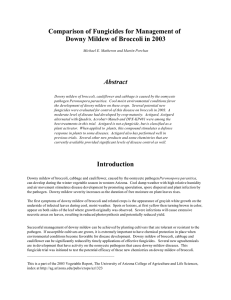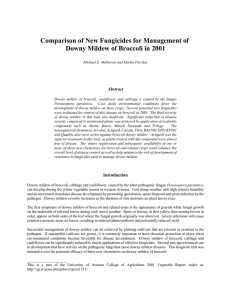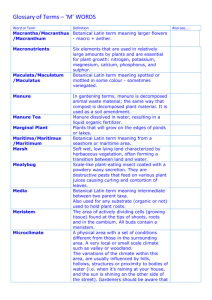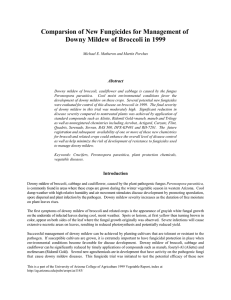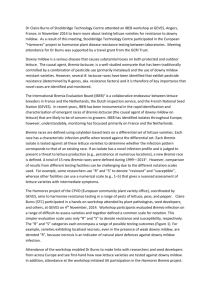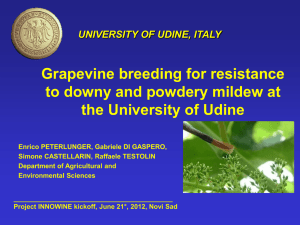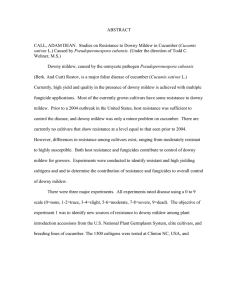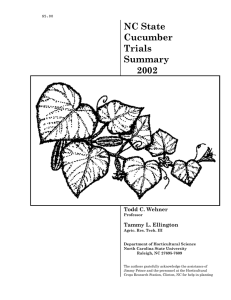Document 11069233
advertisement
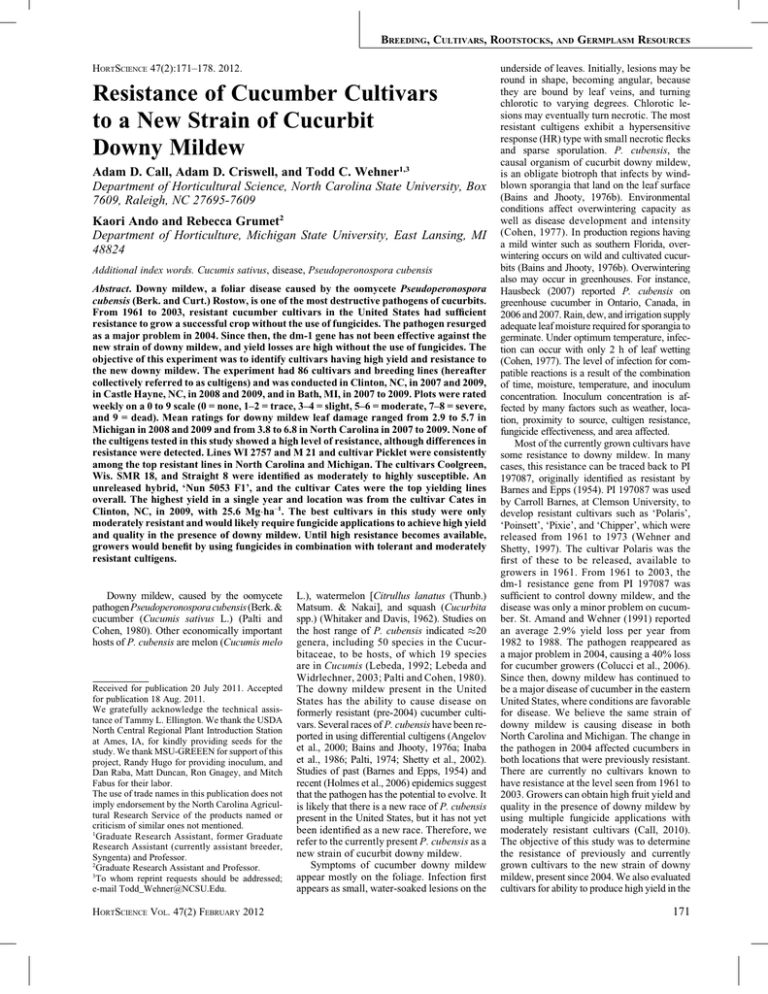
| BREEDING, CULTIVARS, ROOTSTOCKS, AND GERMPLASM RESOURCES HORTSCIENCE 47(2):171–178. 2012. Resistance of Cucumber Cultivars to a New Strain of Cucurbit Downy Mildew Adam D. Call, Adam D. Criswell, and Todd C. Wehner1,3 Department of Horticultural Science, North Carolina State University, Box 7609, Raleigh, NC 27695-7609 Kaori Ando and Rebecca Grumet2 Department of Horticulture, Michigan State University, East Lansing, MI 48824 Additional index words. Cucumis sativus, disease, Pseudoperonospora cubensis Abstract. Downy mildew, a foliar disease caused by the oomycete Pseudoperonospora cubensis (Berk. and Curt.) Rostow, is one of the most destructive pathogens of cucurbits. From 1961 to 2003, resistant cucumber cultivars in the United States had sufficient resistance to grow a successful crop without the use of fungicides. The pathogen resurged as a major problem in 2004. Since then, the dm-1 gene has not been effective against the new strain of downy mildew, and yield losses are high without the use of fungicides. The objective of this experiment was to identify cultivars having high yield and resistance to the new downy mildew. The experiment had 86 cultivars and breeding lines (hereafter collectively referred to as cultigens) and was conducted in Clinton, NC, in 2007 and 2009, in Castle Hayne, NC, in 2008 and 2009, and in Bath, MI, in 2007 to 2009. Plots were rated weekly on a 0 to 9 scale (0 = none, 1–2 = trace, 3–4 = slight, 5–6 = moderate, 7–8 = severe, and 9 = dead). Mean ratings for downy mildew leaf damage ranged from 2.9 to 5.7 in Michigan in 2008 and 2009 and from 3.8 to 6.8 in North Carolina in 2007 to 2009. None of the cultigens tested in this study showed a high level of resistance, although differences in resistance were detected. Lines WI 2757 and M 21 and cultivar Picklet were consistently among the top resistant lines in North Carolina and Michigan. The cultivars Coolgreen, Wis. SMR 18, and Straight 8 were identified as moderately to highly susceptible. An unreleased hybrid, ‘Nun 5053 F1’, and the cultivar Cates were the top yielding lines overall. The highest yield in a single year and location was from the cultivar Cates in Clinton, NC, in 2009, with 25.6 Mg!ha–1. The best cultivars in this study were only moderately resistant and would likely require fungicide applications to achieve high yield and quality in the presence of downy mildew. Until high resistance becomes available, growers would benefit by using fungicides in combination with tolerant and moderately resistant cultigens. Downy mildew, caused by the oomycete pathogen Pseudoperonospora cubensis (Berk. & cucumber (Cucumis sativus L.) (Palti and Cohen, 1980). Other economically important hosts of P. cubensis are melon (Cucumis melo Received for publication 20 July 2011. Accepted for publication 18 Aug. 2011. We gratefully acknowledge the technical assistance of Tammy L. Ellington. We thank the USDA North Central Regional Plant Introduction Station at Ames, IA, for kindly providing seeds for the study. We thank MSU-GREEEN for support of this project, Randy Hugo for providing inoculum, and Dan Raba, Matt Duncan, Ron Gnagey, and Mitch Fabus for their labor. The use of trade names in this publication does not imply endorsement by the North Carolina Agricultural Research Service of the products named or criticism of similar ones not mentioned. 1 Graduate Research Assistant, former Graduate Research Assistant (currently assistant breeder, Syngenta) and Professor. 2 Graduate Research Assistant and Professor. 3 To whom reprint requests should be addressed; e-mail Todd_Wehner@NCSU.Edu. HORTSCIENCE VOL. 47(2) FEBRUARY 2012 L.), watermelon [Citrullus lanatus (Thunb.) Matsum. & Nakai], and squash (Cucurbita spp.) (Whitaker and Davis, 1962). Studies on the host range of P. cubensis indicated "20 genera, including 50 species in the Cucurbitaceae, to be hosts, of which 19 species are in Cucumis (Lebeda, 1992; Lebeda and Widrlechner, 2003; Palti and Cohen, 1980). The downy mildew present in the United States has the ability to cause disease on formerly resistant (pre-2004) cucumber cultivars. Several races of P. cubensis have been reported in using differential cultigens (Angelov et al., 2000; Bains and Jhooty, 1976a; Inaba et al., 1986; Palti, 1974; Shetty et al., 2002). Studies of past (Barnes and Epps, 1954) and recent (Holmes et al., 2006) epidemics suggest that the pathogen has the potential to evolve. It is likely that there is a new race of P. cubensis present in the United States, but it has not yet been identified as a new race. Therefore, we refer to the currently present P. cubensis as a new strain of cucurbit downy mildew. Symptoms of cucumber downy mildew appear mostly on the foliage. Infection first appears as small, water-soaked lesions on the underside of leaves. Initially, lesions may be round in shape, becoming angular, because they are bound by leaf veins, and turning chlorotic to varying degrees. Chlorotic lesions may eventually turn necrotic. The most resistant cultigens exhibit a hypersensitive response (HR) type with small necrotic flecks and sparse sporulation. P. cubensis, the causal organism of cucurbit downy mildew, is an obligate biotroph that infects by windblown sporangia that land on the leaf surface (Bains and Jhooty, 1976b). Environmental conditions affect overwintering capacity as well as disease development and intensity (Cohen, 1977). In production regions having a mild winter such as southern Florida, overwintering occurs on wild and cultivated cucurbits (Bains and Jhooty, 1976b). Overwintering also may occur in greenhouses. For instance, Hausbeck (2007) reported P. cubensis on greenhouse cucumber in Ontario, Canada, in 2006 and 2007. Rain, dew, and irrigation supply adequate leaf moisture required for sporangia to germinate. Under optimum temperature, infection can occur with only 2 h of leaf wetting (Cohen, 1977). The level of infection for compatible reactions is a result of the combination of time, moisture, temperature, and inoculum concentration. Inoculum concentration is affected by many factors such as weather, location, proximity to source, cultigen resistance, fungicide effectiveness, and area affected. Most of the currently grown cultivars have some resistance to downy mildew. In many cases, this resistance can be traced back to PI 197087, originally identified as resistant by Barnes and Epps (1954). PI 197087 was used by Carroll Barnes, at Clemson University, to develop resistant cultivars such as ‘Polaris’, ‘Poinsett’, ‘Pixie’, and ‘Chipper’, which were released from 1961 to 1973 (Wehner and Shetty, 1997). The cultivar Polaris was the first of these to be released, available to growers in 1961. From 1961 to 2003, the dm-1 resistance gene from PI 197087 was sufficient to control downy mildew, and the disease was only a minor problem on cucumber. St. Amand and Wehner (1991) reported an average 2.9% yield loss per year from 1982 to 1988. The pathogen reappeared as a major problem in 2004, causing a 40% loss for cucumber growers (Colucci et al., 2006). Since then, downy mildew has continued to be a major disease of cucumber in the eastern United States, where conditions are favorable for disease. We believe the same strain of downy mildew is causing disease in both North Carolina and Michigan. The change in the pathogen in 2004 affected cucumbers in both locations that were previously resistant. There are currently no cultivars known to have resistance at the level seen from 1961 to 2003. Growers can obtain high fruit yield and quality in the presence of downy mildew by using multiple fungicide applications with moderately resistant cultivars (Call, 2010). The objective of this study was to determine the resistance of previously and currently grown cultivars to the new strain of downy mildew, present since 2004. We also evaluated cultivars for ability to produce high yield in the 171 presence of disease, which we defined as tolerance. Finally, we evaluated the cultivars for components of resistance of their vines: chlorosis and necrosis, stunting, lesion size, and sporulation. Materials and Methods Location and seed sources. Experiments were at the Horticultural Crops Research Stations in Clinton and Castle Hayne, NC, and at the Muck Soil Research Farm in Bath, MI. The study was conducted at Clinton, NC, in 2007 and 2009, at Castle Hayne, NC, in 2008 and 2009, and at Bath, MI, in 2007 to 2009. As a result of low seed availability of some cultivars, some substitutions were made each year. Cultivars tested were obtained from Monsanto/Seminis, Clause/Harris Moran, Bayer/Nunhems, Bejo, Western, Baker, United Genetics, and North Carolina State University. Control cultivars were included for comparison. The checks were 23 cucumber cultivars and breeding lines differing for downy mildew resistance that were also used to evaluate severity of disease in each location and year. Control cultivars were ‘Ashley’ (Clemson University) ‘Calypso’ (North Carolina State University), ‘Coolgreen’ (Asgrow), ‘Dasher II’ (Seminis), Gy 4 (North Carolina State University), ‘Heidan #1’ (PR China), ‘Homegreen #2’ (USDA–Wisconsin), H-19 (University of Arkansas), LJ 90430 (USDA, La Jolla), M 21 (North Carolina State University), M 41 (North Carolina State University), ‘Marketmore 76’ (Cornell University), ‘NongChen #4’ (P.R. China), ‘Poinsett 76’ (Cornell University), ‘Slice’ (Clemson University), ‘Straight 8’ (National Seed Storage Laboratory), ‘Sumter’ (Clemson University), ‘Tablegreen 72’ (Cornell University) ‘TMG-1’ (P.R. China), WI 2238 (USDA–Wisconsin), WI 2757 (USDA–Wisconsin), WI 4783 (USDA–Wisconsin), and ‘Wisconsin SMR 18’ (Wisconsin AES). In Clinton and Castle Hayne, NC, cucumbers were grown using recommended horticultural practices as summarized by Schultheis (1990). Fertilizer was incorporated before planting at a rate of 90N–39P–74K kg!ha–1 with an additional 34 kg N/ha applied at the vine-tipover stage (four to six true leaves). Plots were planted after downy mildew was reported in the county of the test. The field was surrounded by border rows, and spreader rows were spaced every ninth row and planted with susceptible ‘Straight 8’ (2008) and ‘Coolgreen’ (2007 and 2009). Both of these cultigens are highly susceptible having leaves that sporulate heavily and so are ideal for increasing field inoculum. Border and spreader rows were planted on the same day as the test plots with seeds 4 inches to 6 inches apart in the row. Test plots 1.5 m long were hand-seeded on raised, shaped beds with centers 1.5 m apart and thinned to 15 plants before the vinetipover stage (four to six true leaves), equaling a density of 66,666 plants/ha. The study was planted at Clinton, NC, on 9 July 2007 and 18 June 2009 and at Castle Hayne, NC, on 9 July 2008 and 19 June 2009. 172 Table 1. Pearson product-moment correlation coefficients (above diagonal) and Spearman’s rank correlation coefficients (below diagonal) for environments (year · location) of best downy mildew ratings in North Carolina and Michigan from 2007 to 2009.z 2007-CIy 2007-MIx –0.07 Environment (yr · location) 2008-CHw 2008-MIv 2009-CIu 0.42*** 0.21 0.51*** 0.14 0.17 0.07 0.63*** 0.59*** 0.52*** 0.37** 0.53*** 0.31** 0.41*** 0.22 0.55*** 0.44*** 0.24 0.21 2007-CI 2007-MI –0.12 2008-CH 0.38** 0.16 2008-MI 0.13 0.09 2009-CI 0.47*** 0.05 2009-CH 0.69*** –0.13 2009-MI 0.01 0.24 z Data are from four replications. y Data are combined best ratings from Clinton, NC, in 2007. x Data are mean disease rating from Bath, MI, in 2007. w Data are combined best ratings from Castle Hayne, NC, in 2008. v Data are combined best ratings from Bath, MI, in 2008. u Data are combined best ratings from Clinton, NC, in 2009. t Data are combined best ratings from Castle Hayne, NC, in 2009. s Data are combined best ratings from Bath, MI, in 2009. *, **, ***Significant at 0.05, 0.01, and 0.001, respectively. 2009-CHt 0.68*** –0.18 0.47*** 0.28* 0.55*** 2009-MIs 0.07 0.18 0.33** 0.21 0.16 0.15 0.16 Table 2. Downy mildew resistance of cultivars tested in Bath, MI, and Clinton and Castle Hayne, NC, from 2007–2009.z Cultivar or line WI 2238 (R,S) LJ 90430 WI 2757 M 21 Picklet WI 4783 Mopick Invasion Pony NC-Davie Europick HM 82 Cross Country MacArthur Excel Wellington Cates Poinsett 76 H-19 Nun 5053 PU F1 Fanfare Eureka Fancipak Impact Moxie Feisty Spunky Journey Wainwright Lafayette Powerpak Vlasstar Vlaspik Wautoma NongChen #4 Classy Starex Vlasset Stonewall Calypso Stallion Arabian NC-Duplin Colt Navigator Expedition DM Meany 3.6 3.9 4.0 4.2 4.2 4.2 4.3 4.4 4.4 4.5 4.5 4.6 4.6 4.6 4.6 4.6 4.6 4.7 4.7 4.7 4.7 4.7 4.7 4.7 4.7 4.7 4.7 4.7 4.8 4.8 4.8 4.8 4.8 4.8 4.8 4.8 4.9 4.9 4.9 4.9 4.9 4.9 4.9 4.9 4.9 4.9 Mean downy mildew resistance in years and locations 2007 2008 2009 Clintonx Bathw C. Haynev Bathu Clintont C. Haynes Bathr 3.7 3.3 — — — — — 2.3 5.6 — — — — — 4.0 6.3 4.1 3.0 4.5 3.7 . 2.8 7.3 4.8 2.9 4.1 3.8 3.5 3.2 6.0 4.9 3.5 3.9 4.3 3.8 3.4 6.7 3.5 3.1 — — — — — — — 4.7 4.1 4.3 — — — — 5.0 4.1 4.3 3.3 6.6 4.6 3.7 4.5 4.2 3.7 3.1 6.3 5.2 3.9 4.2 4.2 4.3 — — — — 5.0 4.7 3.9 3.6 6.6 5.1 4.0 4.0 4.6 4.0 3.7 7.2 5.1 3.3 4.7 4.1 — 3.8 6.5 5.6 3.9 4.8 3.9 3.6 3.6 6.4 4.9 3.9 4.3 4.5 4.5 3.7 5.3 5.7 3.8 4.8 4.5 4.6 3.2 7.3 4.7 4.0 4.8 4.6 3.9 3.7 7.8 5.0 3.8 4.0 3.7 — — — — — 5.1 5.0 3.9 — — 4.8 3.9 5.7 4.6 4.5 4.2 7.7 5.4 3.3 4.4 3.7 2.5 3.3 7.8 5.6 3.7 4.9 3.9 3.8 3.6 5.9 5.7 4.6 4.9 4.2 4.0 3.8 6.8 5.2 3.7 5.0 4.5 4.0 4.1 5.4 5.9 4.6 4.7 4.6 3.8 3.9 6.7 5.7 3.7 4.8 4.6 4.1 3.7 6.4 5.1 4.1 5.4 4.6 4.2 3.8 6.6 5.3 3.7 5.3 4.5 4.0 3.7 6.6 — — 4.9 4.7 3.8 3.8 6.7 5.2 4.3 5.2 4.4 3.9 3.8 6.4 5.4 4.5 5.2 4.4 3.8 3.5 7.1 5.4 4.4 4.6 4.7 3.8 3.9 6.1 5.4 4.1 4.9 5.1 4.1 3.7 8.0 — — 4.0 3.8 4.1 3.9 7.5 4.3 4.3 5.5 4.8 4.4 3.8 7.0 5.5 3.9 5.2 4.2 4.3 3.9 6.6 5.8 3.8 5.4 4.7 3.8 4.3 6.9 5.3 2.6 6.0 4.7 4.3 3.7 7.8 4.7 4.5 4.4 4.3 4.9 4.3 6.3 6.1 4.7 4.5 4.1 3.1 4.2 7.3 6.4 3.8 5.1 4.5 3.8 4.0 7.1 5.7 3.9 5.2 4.3 4.2 3.6 7.2 5.8 3.8 4.9 4.7 4.3 3.9 6.8 6.0 3.5 5.4 4.5 4.3 3.7 6.4 5.4 4.4 5.6 5.0 4.1 3.9 7.1 5.6 3.9 5.4 4.9 3.8 (Continued on next page) HORTSCIENCE VOL. 47(2) FEBRUARY 2012 In Bath, MI, weed and pest control and fertilizer application were implemented according to recommended cultural practices (Warncke et al., 2004). Rows were covered with 60-cm wide plastic mulch with 1.5- m spacing between row centers. Each plot was 1.5 m long with 20 hills spaced 7.5 cm apart. One or two seeds per hill were sown and thinned to 15 plants, equaling a density of 66,666 plants/ha. Susceptible ‘Straight 8’ was planted in the borders surrounding the field, a row in the center of the field, and in three rows throughout the field to serve as a source of downy mildew inoculum. The spreader rows were planted before the test germplasm plots, on 6 July 2007, 30 June 2008, and 10 July 2009. The test germplasm was planted on 9 Aug. 2007, 30 July 2008, and 20 July 2009. Field ratings. Plots were rated weekly using a 0 to 9 scale (0 = none, 1–2 = trace, 3–4 = slight, 5–6 = moderate, 7–8 = severe, and 9 = dead) that was based on percentage of symptomatic leaf area, a method developed by Jenkins and Wehner (1983). Chlorosis and necrosis were rated as the percentage of leaf area displaying each symptom. During each rating, leaves from all plants in each plot were examined and given a subjective average value of 0 to 9. Stunting was rated as reduction in plant size relative to the larger cultivars used as checks. A low stunting rating indicated the ability of the plant to grow large and branched. Therefore, even without disease, different cultigens would have different stunting ratings. Nevertheless, it allowed us to identify those cultigens that remain large in a disease epidemic. In 2007, stunting ratings were taken in the first three ratings. In 2008, stunting ratings were taken at the final three ratings. In 2007 at Bath, MI, only overall disease was rated using the 0 to 9 scale. In 2008 and 2009, rating of disease symptoms was performed as described previously. Chlorosis and necrosis were rated in 2008 and 2009. Stunting and lesion size data were rated in 2009 (see subsequently for a description of lesion size ratings). In 2009, lesion size ratings were added as the result of another study to identify cultigens having a hypersensitive response. Lesion size was rated using three categories: 1 = small flecks "1.5 mm or less, 5 = medium round or angular lesions but not spread out to be bound by leaf veins, and 9 = large angular lesions bound by leaf veins. The means for lesion size were useful mainly in identifying cultigens at the low or high extremes. For this study, our main focus was to identify cultigens that showed the smallest lesion size, indicated by the smallest overall mean. Sporulation ratings were taken once at Clinton and Castle Hayne, NC, in 2009 only. Ratings were the average severity of sporulation of the three most diseased leaves on a plot based on the 0 to 9 scale described previously. Yield data were taken in 2008 at Castle Hayne, NC, in 2009 at Clinton, NC, and Bath, MI. In Castle Hayne, NC, in 2008, plots were harvested at 48 and 55 d after planting. In HORTSCIENCE VOL. 47(2) FEBRUARY 2012 Table 2. (Continued) Downy mildew resistance of cultivars tested in Bath, MI, and Clinton and Castle Hayne, NC, from 2007–2009.z Cultivar or line Homegreen #2 HM 81 Tablegreen 72 Ballerina Vlasspear Slice Gy 4 Sassy Pershing Jackson (3540) Diamante NC-Danbury WI 1983 Indy Atlantis NC-Stratford M 41 Heidan #1 (I,R) Sumter Greensleaves Marketmore 76 Ashley Dasher II Papillon Talladega Panther Thunder Speedway General Lee Intimidator Montebello Palomino NC-Sunshine Straight 8 Wis. SMR 18 NationlPcklng Coolgreen Least significant difference (5%) DM Meany 5.0 5.0 5.0 5.0 5.0 5.0 5.0 5.0 5.1 5.1 5.1 5.1 5.2 5.2 5.3 5.3 5.3 5.4 5.4 5.4 5.4 5.4 5.5 5.5 5.6 5.6 5.6 5.6 5.6 5.7 5.7 5.7 5.7 6.3 6.5 6.5 6.8 0.3 Mean downy mildew resistance in years and locations 2007 2008 2009 Clintonx Bathw C. Haynev Bathu Clintont C. Haynes Bathr 3.8 7.6 6.1 3.6 5.3 4.2 4.2 3.8 6.8 5.5 4.9 4.6 4.6 4.5 4.5 — 6.0 4.4 5.1 5.0 — — — — — 5.4 5.3 4.3 4.2 6.4 5.7 4.1 5.3 5.1 4.4 3.9 7.6 5.3 5.2 4.8 4.0 4.3 3.6 6.9 5.7 5.3 5.1 4.3 4.4 4.4 7.3 5.1 4.1 5.4 5.0 4.0 3.9 7.7 5.7 4.7 5.3 4.0 4.2 3.8 7.0 5.8 4.2 5.6 4.9 4.0 3.9 7.8 5.4 4.9 5.0 4.1 4.4 — — 5.7 4.6 — — — — — 5.6 4.8 — — — 4.2 7.5 5.4 3.2 5.9 5.5 4.8 4.8 5.7 6.4 3.8 6.0 5.5 4.8 4.2 7.3 6.2 4.1 5.9 5.1 4.3 3.6 7.7 — — — — — 4.1 8.7 — — 5.5 4.0 5.4 4.1 7.9 5.9 4.6 5.4 4.9 5.1 4.6 6.2 6.6 4.9 5.7 5.2 4.8 4.6 8.0 6.0 4.1 5.4 5.1 3.3 4.8 6.9 6.2 4.1 5.7 5.6 5.2 4.6 7.2 6.3 5.0 5.5 5.4 4.3 4.5 7.1 6.2 4.4 6.3 5.6 4.6 5.1 6.4 6.6 5.1 5.5 5.6 4.9 4.5 7.1 6.3 4.4 6.1 5.8 4.5 4.7 6.7 6.9 4.3 6.0 5.6 4.8 — — — — 6.4 5.6 4.9 4.5 7.7 6.7 4.8 6.0 5.1 4.7 4.6 7.1 6.1 4.8 6.0 5.8 5.2 — — — — 6.6 5.7 4.7 5.2 6.2 6.7 3.8 6.9 6.2 4.8 5.0 8.0 6.8 3.8 5.9 5.6 4.7 6.3 8.0 6.9 4.9 7.0 6.2 5.1 5.9 7.6 7.8 5.5 6.8 6.8 5.0 6.3 6.8 — — — — — 6.5 7.8 7.2 5.7 7.1 6.6 — 0.5 1.4 0.8 0.9 0.9 0.7 0.6 12.2 8.1 14.3 10.1 15.9 11.8 10.4 10.3 Data are from four replications for each year, location. Data were standardized to a mean of 4.5 and SD of 1.5. y Downy mildew mean was the mean of all chlorosis and necrosis ratings at all locations in 2009 using a 0 to 9 (0 = none, 1–2 = trace, 3–4 = slight, 5–6 = moderate, 7–8 = severe, and 9 = dead) scale that was based on percentage of symptomatic leaf area. x Data are mean of all chlorosis and necrosis ratings from Clinton, NC, in 2007. w Data are mean disease rating from Bath, MI, in 2007. v Data are mean of all chlorosis and necrosis ratings from Castle Hayne, NC, in 2008. u Data are mean of all chlorosis and necrosis ratings from Bath, MI, in 2008. t Data are mean of all chlorosis and necrosis ratings from Clinton, NC, in 2009. s Data are mean of all chlorosis and necrosis ratings from Castle Hayne, NC, in 2009. r Data are mean of all chlorosis and necrosis ratings from Bath, MI, in 2009. CV z Table 3. Downy mildew resistance of cultivars tested in Bath, MI, 2008 to 2009.z Cultivar or line Fanfare M 21 Cross Country Vlasset Picklet Marketmore 76 Pony MacArthur Eureka Stallion Journey Source Seminis NC State Univ. Harris Moran Seminis Seminis Cornell Univ. Seminis Nunhems Seminis Seminis Seminis DM Meany 2.9 3.2 3.3 3.4 3.6 3.7 3.7 3.7 3.8 3.8 3.8 Disease components Chlorosis Necrosis Meanx Maximumw Meanx Maximumw 3.3 4.4 2.5 3.4 2.5 3.4 3.7 6.1 3.3 4.5 3.3 5.3 3.1 4.5 3.8 5.3 3.5 4.9 3.8 5.1 4.0 5.3 3.4 4.6 3.2 3.8 4.3 5.5 3.7 5.0 3.8 4.8 3.8 5.6 3.7 5.5 3.5 5.0 4.0 5.5 3.8 5.3 3.8 4.8 (Continued on next page) 173 Table 3. (Continued) Downy mildew resistance of cultivars tested in Bath, MI, 2008 to 2009.z Cultivar or line Starex Poinsett 76 Impact Expedition Homegreen #2 Calypso Colt Feisty Cates Indy HM 82 Arabian Sassy NC-Davie NC-Duplin Jackson (3540) Lafayette Vlasstar Classy Vlaspik Spunky Powerpak NC-Stratford Excel Moxie Nun 5053 PU F1 Wellington NC-Sunshine Atlantis Navigator Vlasspear Palomino NongChen #4 Fancipak Ballerina Tablegreen 72 Pershing Panther Papillon Thunder NC-Danbury Ashley Diamante HM 81 Stonewall Dasher II Slice General Lee WI 1983 Gy 4 Sumter Greensleaves Talladega Straight 8 Intimidator Wis. SMR 18 Coolgreen Least significant difference (5%) Source Baker Cornell Univ. Western Seminis USDA–Wis. NC State Univ. Seminis Harris Moran Nunhems Seminis Harris Moran Seminis Harris Moran Zeraim Gedera NC State Univ. Nunhems Nunhems Seminis Harris Moran Seminis Harris Moran Seminis NC State Univ. Seminis Harris Moran Nunhems Seminis NC State Univ. Bejo Seeds Seminis Seminis Seminis PR China Seminis Nunhems Cornell Univ. Nunhems Nunhems Seminis Seminis NC State Univ. Clemson Univ. Harris Moran Harris Moran Harris Moran Petoseed Clemson Univ. Harris Moran USDA–Wis. NC State Univ. Clemson Univ. Harris Moran Seminis NSSL Seminis Wisconsin AES Asgrow Seed DM Meany 3.8 3.8 3.8 3.9 3.9 3.9 3.9 3.9 4.0 4.0 4.0 4.0 4.1 4.1 4.1 4.1 4.1 4.1 4.1 4.1 4.2 4.2 4.2 4.2 4.2 4.2 4.2 4.2 4.3 4.3 4.3 4.3 4.3 4.3 4.3 4.4 4.4 4.5 4.5 4.5 4.6 4.7 4.7 4.7 4.7 4.7 4.7 4.8 4.8 4.8 4.8 4.9 5.0 5.0 5.0 5.2 5.7 0.6 Disease components Chlorosis Necrosis Meanx Maximumw Meanx Maximumw 3.8 5.1 3.9 5.6 4.1 6.0 3.6 5.5 4.1 5.8 3.6 5.0 3.7 5.3 4.0 5.4 4.0 5.5 3.7 5.6 3.8 5.6 3.9 5.3 3.5 5.4 4.2 5.7 3.6 5.0 4.3 5.3 3.6 5.1 4.4 5.4 5.0 6.5 3.0 4.5 3.8 5.5 4.3 5.9 3.8 5.3 4.3 5.8 3.7 4.6 4.4 5.9 4.3 6.0 3.7 5.1 4.2 5.6 3.8 6.0 3.8 5.7 4.4 5.5 4.0 5.6 4.2 5.5 3.8 4.9 4.4 6.4 4.2 5.6 4.0 5.5 3.7 5.3 4.5 5.7 4.2 5.6 4.1 5.5 3.8 5.1 4.5 5.6 5.0 6.1 3.3 4.0 4.2 5.8 4.1 5.9 4.0 5.5 4.5 6.3 4.4 6.1 4.0 4.8 3.9 5.3 4.7 5.9 5.1 6.4 3.4 4.5 5.3 6.8 3.2 4.5 4.0 5.9 4.5 6.0 4.0 5.8 4.6 6.0 5.0 6.3 3.5 5.4 4.7 6.4 4.0 5.5 4.2 5.6 4.5 5.8 5.7 6.8 2.9 3.5 4.4 6.5 4.3 6.0 4.3 5.9 4.5 5.8 5.1 6.9 3.7 5.3 4.9 6.3 4.2 5.5 5.3 6.9 3.8 4.9 4.1 6.3 5.1 8.0 5.8 6.9 3.6 5.3 4.3 6.3 5.1 6.4 5.0 7.1 4.3 5.8 4.5 6.1 5.0 6.6 5.5 7.1 3.8 4.9 4.8 6.8 4.7 6.0 5.4 6.8 4.2 5.4 4.9 6.5 4.7 6.3 4.8 6.6 4.7 6.8 4.9 6.5 4.8 6.9 5.8 6.9 3.9 5.3 5.8 7.8 4.3 5.9 5.6 7.6 4.3 5.8 5.6 7.3 4.5 5.9 6.3 7.8 4.1 5.8 5.9 7.7 5.4 7.0 0.7 0.9 0.8 1.2 11.2 12.6 13.8 16.0 16.9 Data are from four replications each in Bath, MI, in 2008 and 2009. y DM mean is mean of all chlorosis and necrosis ratings using a 0 to 9 (0 = none, 1–2 = trace, 3–4 = slight, 5– 6 = moderate, 7–8 = severe, and 9 = dead) scale that was based on percentage of symptomatic leaf area. x Trait mean is the mean of all ratings for the specified trait using a 0 to 9 (0 = none, 1–2 = trace, 3–4 = slight, 5–6 = moderate, 7–8 = severe, and 9 = dead) scale that was based on percentage of symptomatic leaf area. w Trait maximum is the maximum individual rating (date) for a plot averaged over replications, locations, and years. CV z 174 Clinton, NC, in 2009, plots were harvested at 46 and 60 d after planting. In Bath, MI, in 2009, plots were harvested at 45 and 52 d after planting. Plots were harvested by hand and graded into marketable and cull fruit. Cull fruit were crooked or nubbined according to industry standards. Number of fruit and total weight were recorded for marketable and cull fruit for each plot. Plots were harvested twice. Inoculum source. No artificial inoculation was used in the field tests in North Carolina. Plots were exposed to natural epidemics during the growing season. Epidemics were encouraged using overhead irrigation. At Bath, MI, plants having downy mildew were brought from commercial fields in Arenac County to inoculate the spreader rows directly. Overhead irrigation was applied after the inoculum was brought to the field to promote disease development and spread throughout the field. Experiment design. Cultigens were grown under heavy downy mildew incidence in the field. The experiment was a randomized complete block design with four replications in each location · year. In 2007, the locations were Clinton, NC, and Bath, MI. In 2008, the locations were Castle Hayne, NC, and Bath, MI, with yield taken in the two North Carolina locations only. In 2009, the study was grown at three locations (Clinton, NC; Castle Hayne, NC; Bath, MI), with yield data taken at all locations. Data were analyzed using the general linear models, means, and correlation procedures of SAS 9.1 (SAS Institute, Inc., Cary, NC). Data were analyzed combined and separately for North Carolina and Michigan. Combined data were also analyzed as seven environments (year · location combinations) to calculate correlation between pairs of disease components and trait means for each of the cultigens tested. A combined best rating was devised based on F-test ratios for downy mildew component ratings in environments (years · locations) to compare environments using the mean of the best (having the highest F-ratio for cultigen, data not presented) chlorosis and necrosis ratings for each environment. This rating was used for correlations and environment means and termed DM best rating. Results and Discussion Disease resistance. None of the cultivars evaluated in this study had the high level of resistance observed between 1961 and 2003. This result is most likely attributable to a change in the pathogen population in 2004, when downy mildew resurged to become a major disease of cucumbers in humid growing regions. However, differences in cultigens were observed, and cultigens were identified that can be grown in the presence of the current downy mildew, although in most cases, multiple fungicide applications would likely be required for a grower to achieve satisfactory yield and quality. Data from Michigan in 2007 were analyzed separately because only overall disease was rated. Overall disease was a combined HORTSCIENCE VOL. 47(2) FEBRUARY 2012 rating of chlorosis and necrosis that did not incorporate stunting or lesion size. Over the six remaining environments in which disease components were rated, effects of all sources of variation (year, location, year · location, replication within year · location, cultigen, cultigen · year, cultigen · location, and cultigen · year · location) were significant (P = 0.001) for chlorosis and necrosis. A significant (P = 0.001) effect on stunting was observed for year, location, replication within year · location, cultigen, cultigen · year, and cultigen · location. However, cultigen interactions with year, location, and year · location were relatively small for each of these traits. Individual analysis of variance (ANOVA) was done separately for each environment (year · location) for which the variance terms were replication and cultivar only. For all environments, a significant (P = 0.001) cultivar effect was observed for chlorosis, necrosis, and stunting ratings. A significant (P = 0.001) cultivar effect was observed in all environments for total yield, percentage marketable yield, percentage early yield, and mean fruit weight. For a complete report of the ANOVA, see Call (2010). Correlations of environments for disease were calculated using the combined best rating of components for all environments, except Michigan in 2007, for which we used the mean overall rating (Table 1). Pearson and Spearman correlations gave similar results. Unless otherwise stated, correlations presented here are results from Pearson correlations. See Call (2010) for a complete report of Pearson and Spearman correlations. The data from Michigan in 2007 were not significantly correlated (–0.13 # R2 # 0.24) with any other environment. All North Carolina environments were significantly correlated (0.42 # R2 # 68) at P < 0.001. There was no significant correlation (0.07 # R2 # 0.21) between years at the Michigan location. All environments were significantly correlated (0.47 # R2 # 0.69) for total and marketable yield at P < 0.001. Overall environments (excluding Michigan in 2007) chlorosis and necrosis were significantly correlated (R2 = 0.64 and 0.55 for Pearson and Spearman correlations, respectively) at P < 0.001. Stunting was not correlated (R2 = 0.04) with either chlorosis or necrosis. Cultigen performance over environments for data that were standardized to a mean of 4.5 and SD of 1.5 is presented in Table 2. Data from Michigan in 2007 were a single rating of combined chlorosis and necrosis, whereas the rest of the data were the mean of separate individual chlorosis and necrosis rating. We feel the comparison is valid because the overall rating in Michigan is really a combination of chlorosis and necrosis. Chlorosis and necrosis are also highly correlated (Pearson R2 = 0.64, P < 0.0001) and likely the same trait. We believe that these are the essentially the same trait and that environmental conditions are the main factor affecting the relative phenotypic display of each trait. The most resistant cultigens tested in at least one location in each year were WI 2757, HORTSCIENCE VOL. 47(2) FEBRUARY 2012 Table 4. Downy mildew resistance components for cultivars tested in Clinton and Castle Hayne, NC, 2007 to 2009.z Cultivar or line Wautoma M 21 Picklet Poinsett 76 NC-Davie Pony Stonewall Cates HM 82 Excel Mopick Cross Country Wainwright Eureka Fanfare Slice MacArthur Vlasstar NongChen #4 Fancipak Diamante HM 81 Impact Lafayette Classy Powerpak Wellington Gy 4 Spunky Feisty Pershing Journey Calypso NC-Duplin Arabian Vlaspik Homegreen #2 Moxie Navigator Colt Expedition Starex Sassy Jackson (3540) Nun 5053 PU F1 Stallion Vlasspear Vlasset Sumter Tablegreen 72 Indy Marketmore 76 NC-Stratford Dasher II Greensleaves Ashley General Lee Intimidator Papillon Atlantis Panther Talladega Thunder NC-Sunshine Palomino Straight 8 Wis. SMR 18 Coolgreen Source Wis–USDA NC State Univ. Seminis Cornell Univ. Zeraim Gedera Seminis Harris Moran Nunhems Harris Moran Seminis United Gen. Harris Moran Nunhems Seminis Seminis Clemson Univ. Nunhems Seminis PR China Seminis Harris Moran Harris Moran Western Nunhems Harris Moran Seminis Seminis NC State Univ. Harris Moran Harris Moran Nunhems Seminis NC State Univ. NC State Univ. Seminis Seminis USDA–Wis. Harris Moran Seminis Seminis Seminis Baker Harris Moran Nunhems Nunhems Seminis Seminis Seminis Clemson Univ. Cornell Univ. Seminis Cornell Univ. NC State Univ. Petoseed Harris Moran Clemson Univ. Harris Moran Seminis Seminis Bejo Seeds Nunhems Seminis Seminis NC State Univ. Seminis NSSL Wisconsin AES Asgrow Seed Downy mildew disease components DM Chlorosis Necrosis Stunting Meany Meanx Maximumw Meanx Maximumw Meanx Maximumw 3.8 3.7 5.3 3.8 5.9 4.5 5.4 3.9 3.7 5.9 3.9 6.6 4.7 5.8 4.1 3.9 5.6 4.3 6.4 4.2 5.3 4.1 4.0 5.8 4.2 6.5 4.5 5.5 4.2 4.0 5.8 4.3 6.7 3.7 4.8 4.2 3.8 5.6 4.5 6.6 3.5 4.7 4.2 3.6 5.4 4.9 7.2 3.1 4.4 4.3 4.0 5.4 4.5 6.9 3.2 4.6 4.3 4.1 6.2 4.4 6.8 4.4 5.6 4.3 4.1 6.0 4.4 6.9 4.1 5.4 4.4 4.1 5.8 4.3 6.8 3.6 4.8 4.4 3.9 5.6 4.9 7.3 3.8 4.9 4.4 4.0 5.5 4.5 7.2 3.2 4.8 4.4 4.2 5.7 4.7 6.7 4.1 5.4 4.4 4.0 6.1 4.9 6.9 5.5 6.7 4.5 3.8 5.8 5.1 7.3 2.7 3.9 4.5 4.1 5.9 5.0 6.8 4.2 5.6 4.5 4.1 5.9 5.0 7.2 3.4 4.5 4.6 4.9 6.7 4.4 6.9 3.5 4.6 4.6 4.4 5.9 4.9 7.0 2.5 3.8 4.6 4.1 5.8 5.1 7.1 2.7 3.9 4.6 4.6 6.1 4.6 6.7 3.2 4.3 4.6 4.2 5.8 5.0 7.2 3.3 4.3 4.6 4.3 5.8 5.0 7.2 3.6 4.9 4.7 4.5 6.3 4.8 6.9 3.1 4.6 4.7 3.9 5.9 5.4 7.4 3.1 4.6 4.7 4.2 6.1 5.1 7.4 4.0 5.4 4.7 4.5 6.1 4.8 7.0 3.8 5.1 4.7 4.4 6.1 5.1 7.3 2.7 4.1 4.7 4.1 5.6 5.3 7.3 3.3 4.6 4.7 4.2 5.8 5.2 7.3 3.7 5.2 4.7 4.3 5.8 5.0 7.1 3.7 5.1 4.7 4.8 5.9 4.7 6.8 3.4 5.0 4.8 4.3 6.3 5.2 7.1 3.8 5.0 4.8 4.4 6.2 5.2 7.1 4.3 5.6 4.8 4.5 6.3 5.1 7.2 3.4 4.6 4.8 4.9 6.6 4.8 6.9 5.4 6.5 4.8 4.4 6.2 5.2 7.3 3.2 4.4 4.9 4.5 6.4 5.1 7.1 3.5 5.1 4.9 4.5 5.9 5.3 7.4 3.6 4.9 4.9 4.7 6.4 5.1 7.1 3.9 5.6 4.9 4.7 6.3 5.1 7.2 2.5 3.8 5.0 4.3 6.2 5.5 7.3 3.7 5.6 5.0 4.6 6.6 5.5 7.4 4.3 5.9 5.0 4.8 6.3 5.1 7.3 4.3 5.9 5.0 4.5 6.6 5.4 7.8 4.1 5.4 5.0 4.8 6.6 5.1 7.3 3.8 5.3 5.1 4.7 6.3 5.3 7.2 4.1 5.4 5.1 4.8 6.4 5.3 7.3 4.2 5.6 5.1 5.3 6.7 5.0 7.1 5.2 6.5 5.2 5.3 6.8 5.1 6.9 3.1 4.4 5.3 5.5 7.3 5.0 6.8 4.4 5.4 5.4 5.5 7.1 5.2 7.4 4.1 5.6 5.5 5.6 6.9 5.4 7.4 2.8 4.5 5.5 5.8 7.2 5.3 7.3 3.1 4.2 5.5 5.9 6.9 5.2 7.3 3.9 5.1 5.6 5.7 6.8 5.5 7.4 2.8 4.1 5.6 5.7 7.1 5.5 7.2 3.0 4.4 5.7 5.9 7.4 5.3 7.3 3.3 4.9 5.7 5.9 7.3 5.4 7.5 4.1 5.7 5.7 5.8 7.1 5.6 7.3 3.2 4.4 5.7 5.6 7.2 5.7 7.4 3.7 5.3 5.8 5.9 7.1 5.6 7.6 2.9 4.4 5.8 6.0 7.2 5.5 7.7 4.7 5.9 6.2 6.2 7.7 6.2 7.9 3.9 5.2 6.6 6.6 7.8 6.5 8.1 5.1 6.7 6.8 7.0 8.1 6.6 8.1 4.3 5.9 6.8 7.0 8.3 6.6 8.1 6.1 7.5 (Continued on next page) 175 Table 4. (Continued) Downy mildew resistance components for cultivars tested in Clinton and Castle Hayne, NC, 2007 to 2009.z Cultivar or line Least significant difference (5%) Source Downy mildew disease components DM Chlorosis Necrosis Stunting Meany Meanx Maximumw Meanx Maximumw Meanx Maximumw 0.4 0.4 0.5 0.5 0.5 0.7 0.8 10.5 12.2 12.0 13.5 10.4 25.1 21.8 Data are from four replications each at Clinton, NC, in 2007 and 2009, and at Castle Hayne, NC, in 2008 and 2009. y DM mean is mean of all chlorosis and necrosis ratings using a 0 to 9 (0 = none, 1–2 = trace, 3–4 = slight, 5– 6 = moderate, 7–8 = severe, and 9 = dead) scale that was based on percentage of symptomatic leaf area. x Trait mean is the mean of all ratings for the specified trait using a 0 to 9 (0 = none, 1–2 = trace, 3–4 = slight, 5–6 = moderate, 7–8 = severe, and 9 = dead) scale that was based on percentage of symptomatic leaf area. w Trait maximum is the maximum individual rating (date) for a plot averaged over replications, locations, and years. CV z Table 5. Total yield in Mg!ha–1 and percent marketable fruit for North Carolina and Michigan locations in 2008–2009.z Yr and location 08 NC-CHx 09 NC-CIw 09 MI-LSv Meany Cultivar or line Total Mg!ha–1 Total Mg!ha–1 % Mrk. Total Mg!ha–1 % Mrk. Total Mg!ha–1 % Mrk. WI 1983 14.8 14.8 45 — — — — Nun 5053 PU F1 12.9 9.0 56 20.3 87 16.0 90 Cates 12.5 11.8 47 25.6 64 5.3 71 Starex 10.7 12.0 51 23.8 63 1.7 58 Pony 9.4 9.1 50 20.0 72 1.4 72 Vlasspear 8.9 10.4 58 15.4 64 4.2 83 Classy 8.8 7.1 32 18.4 72 2.6 58 Fancipak 8.5 8.6 73 17.0 56 2.1 89 Spunky 8.4 5.5 27 19.6 68 3.9 35 Ballerina 8.1 — — 12.4 73 6.1 93 Vlaspik 7.9 10.2 32 14.8 51 2.4 71 Lafayette 7.8 8.1 45 15.9 60 4.1 80 Journey 7.4 4.7 43 15.6 68 3.6 52 Stallion 7.4 7.7 32 16.1 66 3.1 59 Atlantis 7.3 8.7 36 12.9 58 5.5 95 NC-Davie 7.1 5.9 40 15.4 69 0.4 44 Vlasstar 6.9 3.5 27 12.4 60 2.8 73 Powerpak 6.9 6.7 49 12.0 63 4.6 71 Expedition 6.8 6.6 49 13.0 68 3.6 60 Papillon 6.6 5.3 38 13.7 75 3.3 65 NongChen #4 6.5 0.2 0 16.9 58 1.2 36 Indy 6.5 0.6 42 20.0 54 2.1 49 Thunder 6.5 5.0 32 13.1 57 2.6 59 Palomino 6.4 5.4 33 12.5 45 4.2 51 Mopick 6.2 — — 13.6 43 2.2 71 Wainwright 6.1 0.0 — 16.1 50 3.9 69 Feisty 6.0 6.1 59 10.8 46 3.8 79 M 21 6.0 4.0 32 13.7 71 0.5 32 Arabian 5.9 4.6 51 14.3 70 2.3 53 Calypso 5.8 6.3 33 10.5 59 0.0 — NC-Stratford 5.4 3.7 19 14.1 61 1.6 53 Wellington 5.3 4.7 38 11.1 74 1.8 89 Navigator 5.3 3.2 25 14.4 87 2.3 90 Greensleaves 5.3 4.9 37 13.0 63 1.2 15 Excel 5.2 2.9 71 10.4 55 3.3 51 Jackson (3540) 5.1 4.0 38 10.7 56 2.7 95 General Lee 5.0 4.0 39 12.2 62 1.5 47 Colt 4.8 2.9 17 11.3 74 2.1 61 Montebello 4.6 — — 11.8 53 0.6 63 Moxie 4.6 3.6 17 9.1 27 4.3 46 Heidan #1 (I,R) 4.3 0.0 — 6.2 64 0.0 — Talladega 4.3 4.8 19 6.7 56 3.9 55 NC-Duplin 4.2 2.6 40 9.2 41 1.8 90 Europick 4.2 — — 10.1 57 0.8 86 Diamante 4.1 4.4 6 10.5 61 0.2 0 Cross Country 4.1 4.8 27 10.7 50 0.0 — Intimidator 4.1 2.8 24 4.7 46 3.0 36 Sassy 4.0 3.9 42 6.9 51 3.4 78 Picklet 4.0 2.1 20 8.4 80 1.1 100 Impact 4.0 2.6 2 9.4 74 1.4 36 (Continued on next page) 176 ‘Cross Country’, ‘Picklet’, and M 21. Both M 21 and WI 2757 were highly resistant in a screening done in 1988 and 1989 by Wehner and Shetty (1997). ‘Cross Country’ was moderately resistant, but none of those three were significantly different from each other. ‘Picklet’ was not tested in that screening. Wehner and Shetty (1997) classified 17 cultigens as highly resistant. There were no highly resistant cultigens in our study, and those that were previously highly resistant are now only moderately resistant. In our study, the least resistant cultigens tested in at least one location per year were ‘Coolgreen’, ‘Wisconsin SMR 18’, and ‘Straight 8’. In the screening by Wehner and Shetty (1997), both ‘Coolgreen’ and ‘Straight 8’ were susceptible and were not significantly different from the most susceptible lines tested. ‘Wisconsin SMR 18’ and ‘Palomino’ were not included in that screening. In Michigan in 2007, no component traits were rated, and the data collected consisted of only an overall disease rating. The most resistant cultigens were WI 2238, ‘Wellington’, ‘Moxie’, ‘LJ 90430’, ‘Atlantis’, ‘Fancipak’, ‘Picklet’, and ‘Vlaspik’. Line WI 2238 was the most resistant cultigen tested in this environment and was significantly better than all other cultigens. Unfortunately, limited seed supply made WI 2238 unavailable for testing in 2008 and 2009. Line ‘LJ 90430’ is a wild relative (Cucumis sativus var. hardwickii) of cucumber with late emergence. Its ranking may be misleading because part of its resistance is likely the result of disease avoidance. Line M 21, a moderately resistant cultigen that performed well in other environments, was not significantly different from susceptible ‘Wisconsin SMR 18’ and ‘Coolgreen’ in Michigan in 2007. Downy mildew chlorosis and necrosis components were rated in Bath, MI, in 2008 and 2009 (Table 3). Cultigens were ranked by downy mildew mean, which was the mean of all chlorosis and necrosis ratings. The most resistant cultigens in Michigan in 2008 and 2009 using combined mean were ‘Fanfare’, M 21, ‘Cross Country’, and ‘Vlasset’. There were 18 other cultigens ranking lower but not significantly different from ‘Vlasset’. Other moderately resistant cultivars were also identified. The least resistant cultigens were ‘Coolgreen’, ‘Wisconsin SMR 18’, and ‘Straight 8’. This is expected because these have been shown to be susceptible in previous studies (Wehner and Shetty, 1997), and these cultigens are used as susceptible checks and spreader rows in downy mildew studies at North Carolina State University. Combined means and maximums for chlorosis, necrosis, and stunting from North Carolina environments over 2007, 2008, and 2009 are shown in Table 4. The cultigens were ranked as described previously. The most resistant cultigens using the combined best rating were ‘Wautoma’, M 21, ‘Picklet’, and ‘Poinsett 76’. None of these were in the top 25 yielding cultigens when ranked by means in all environments in which yield was taken (Table 5). There were 14 other cultivars not significantly different from ‘Poinsett 76’ HORTSCIENCE VOL. 47(2) FEBRUARY 2012 Table 5. (Continued) Total yield in Mg!ha–1 and percent marketable fruit for North Carolina and Michigan locations in 2008–2009.z Yr and location 08 NC-CHx 09 NC-CIw 09 MI-LSv Meany Cultivar or line Total Mg!ha–1 Total Mg!ha–1 % Mrk. Total Mg!ha–1 % Mrk. Total Mg!ha–1 % Mrk. Gy 4 3.7 4.2 18 6.2 68 1.5 49 Vlasset 3.5 0.7 25 9.4 58 1.8 86 Invasion 3.4 — — 8.5 43 0.5 0 Stonewall 3.4 1.5 9 9.9 40 0.4 25 Eureka 3.4 3.2 41 8.9 58 0.0 — NC-Sunshine 3.4 6.0 42 2.9 17 0.3 0 MacArthur 3.2 4.7 41 4.1 27 1.4 72 Dasher II 3.1 4.3 12 5.6 14 1.5 46 Pershing 3.1 1.2 21 7.7 34 1.8 53 Speedway 3.1 — — 6.4 33 2.4 28 HM 81 3.0 2.2 25 6.0 35 1.4 70 Panther 2.6 3.9 17 5.6 22 0.5 83 Slice 2.3 1.8 7 6.3 35 0.0 — HM 82 2.2 1.9 16 3.6 25 1.4 58 Ashley 1.7 2.7 24 2.7 0 0.0 — Poinsett 76 1.6 1.2 13 4.0 49 0.0 — LJ 90430 1.5 0.0 — 5.3 92 0.5 0 Fanfare 1.3 0.3 0 4.5 34 0.1 0 WI 4783 0.9 0.9 17 — — — — Wautoma 0.8 0.0 — 2.2 32 0.6 100 WI 2757 0.7 0.1 0 2.0 44 0.0 — Sumter 0.6 0.3 7 1.4 0 0.3 100 H-19 0.4 0.0 — 0.7 79 0.0 — Marketmore 76 0.2 0.0 — 0.7 0 0.0 — NC-Danbury 0.1 0.1 0 — — — — National Pickling 0.1 0.1 0 — — — — Wis. SMR 18 0.1 0.1 0 0.4 36 0.0 — Tablegreen 72 0.0 0.0 — 0.1 100 0.0 — TMG-1 0.0 0.0 — — — — — M 41 0.0 0.0 — — — — — WI 2238 (R,S) 0.0 0.0 — — — — — Homegreen #2 0.0 0.0 — 0.0 — 0.0 — Straight 8 0.0 0.0 — 0.0 — 0.0 — Coolgreen 0.0 0.0 — 0.0 — 0.0 — Least significant 4.9 4.2 31 9.1 30 2.9 39 difference (5%) CV 79.0 76.0 69.8 74.5 77.7 86.3 46.2 All environment correlations significant at P < 0.001 for total and marketable yield. z Data are from two harvests for each year and location. y Mean total Mg!ha–1 over the three environments in which yield were taken. x Data are mean total Mg!ha–1 yield and percent marketable (non-cull) fruit from Castle Hayne, NC, 2008. w Data are mean total Mg!ha–1 yield and percent marketable (non-cull) fruit from Clinton, NC, 2009. v Data are mean total Mg!ha–1 yield and percent marketable (non-cull) fruit from Bath, MI, 2009. for disease. Other cultigens were identified that were moderately resistant as well. It is not surprising that many cultivars were moderately resistant and similar to ‘Poinsett 76’. The resistance from ‘Poinsett 76’ is originally from PI 197087 and shared among many cultivars in this study. The least resistant cultigens were ‘Coolgreen’, ‘Wisconsin SMR 18’, ‘Straight 8’, and ‘Palomino’. The lesion size component was added in 2009 after observing differences in another study. Most cultigens in this study were in the ‘‘large’’ category for lesion size, but a few had smaller lesions, including M 21, ‘Picklet’, ‘Eureka’, ‘Cates’, ‘NC-Duplin’, Nun 5053 PU F1, ‘NongChen #4’, and ‘Heidan #1’. ‘Heidan #1’ was the only cultigen that showed significantly smaller lesion size for all locations tested. The small lesions on ‘Heidan #1’ were mostly chlorotic and would not be described as a hypersensitive response, because they did not turn necrotic. Cultigens with relatively small lesions may be superior to cultigens with larger lesion size as a result of a HORTSCIENCE VOL. 47(2) FEBRUARY 2012 possible reduction in the loss of photosynthetic area. There is also potential for less sporulation, especially in cultigens with a hypersensitive response, potentially reducing secondary inoculum spread. Sporulation is difficult to rate and was evaluated only once in each environment. One issue in trying to rate sporulation in the field is dirt splashed on the underside of leaves as a result of rain and/or overhead irrigation. The sporulation event must also coincide with the 1 or 2 d a week that we are at each individual station for ratings. It is difficult to draw conclusions from a single rating for sporulation, but the three cultigens with the most sporulation were among the five least resistant cultigens in 2009 at Clinton, NC, and Castle Hayne, NC (data not presented). Many cultigens in this study were moderately resistant, and no highly resistant cultigens were identified. In a screening done in North Carolina in 1988 and 1989, Wehner and Shetty (1997) reported that Gy 4, ‘Poinsett 76’, and M 21 were the most resistant. We found those cultigens to be moderately resistant with M 21 and ‘Poinsett 76’ ranking near the top in resistance in both Michigan and North Carolina. All of these have PI 197087 in their pedigree as the source of downy mildew resistance. It is possible that differences in these cultigens could result from the presence of the resistance gene from P.R. 40, used by Carroll Barnes in developing ‘Palmetto’. The resistance in ‘Palmetto’ was quickly overcome but may still provide some resistance. For instance, resistance in the cultivar Ashley can be traced back to P.R. 40 (Barnes and Epps, 1956), and that cultigen is slightly more resistant than the most susceptible cultigens. The combination of resistance tracing from PI 197087 and P.R. 40 could provide a higher level of resistance than either alone. The fact that both of these resistance genes have been overcome, yet still provide some level of resistance compared with susceptible checks, indicates that there may be residual effects with these genes and therefore would still be useful in breeding programs, especially the resistance from PI 197087. Fruit yield. Yield was evaluated in Castle Hayne, NC, in 2008, and Clinton, NC, in 2009, and Bath, MI, in 2009 using two harvests (Table 5). Cultigens were ranked by total yield. The highest yielding cultigens were WI 1983, Nun 5053 PU F1, ‘Cates’, ‘Starex’, and ‘Pony’. Line WI 1983 was tested only in 2008 as a result of seed availability, but it was the second highest yielding cultigen that year. An experimental Nunhems hybrid (Nun 5053 PU F1) yielded well with a high percentage of marketable fruit but was not one of the most resistant cultigens at Michigan or North Carolina. This is an example of tolerance. Tolerance is the ability to yield under disease pressure. Fortyseven cultivars yielded below the least significant difference (5%) of 4.9 Mg!ha–1. The highest yielding cultivar was ‘Cates’ in Clinton, NC, in 2009 with 25.6 Mg!ha–1. Neither chlorosis nor necrosis was significantly correlated with yield, although the most susceptible cultigens all had essentially no yield. Stunting was significantly correlated with both total Mg!ha–1 (R2 = –0.45, P < 0.0001) and marketable Mg!ha–1 (R2 = –0.38, P = 0.0004). Less stunted plants are larger and therefore have more photosynthetic leaf area for fruit production. Conclusions From 1961 to 2003, resistant cucumber cultivars were available in the United States that were highly resistant to downy mildew, and no fungicide was needed for control of the disease. None of these cultigens tested as highly resistant in this study, but there were significant differences among cultigens for resistance, and moderately resistant cultigens were identified. Growers would benefit by using cultigens having the highest resistance and the highest tolerance for downy mildew. Literature Cited Angelov, D., P. Georgiev, and L. Krasteva. 2000. Two races of Pseudoperonospora cubensis on 177 cucumbers in Bulgaria. In: Katzir, N. and H.S. Paris (eds.). Proc. Cucurbitaceae 2000. ISHS Press, Ma’ale Ha Hamisha, Israel. p. 81–83. Bains, S.S. and J.S. Jhooty. 1976a. Host-range and possibility of pathological races in Pseudoperonospora cubensis—Cause of downy mildew of muskmelon. Indian Phytopathol. 29:214–216. Bains, S.S. and J.S. Jhooty. 1976b. Overwintering of Pseudoperonospora cubensis causing downy mildew of muskmelon. Indian Phytopathol. 29: 213–214. Barnes, W.C. and W.M. Epps. 1954. An unreported type of resistance to cucumber downy mildew. Plant Dis. Rptr. 38:620. Barnes, W.C. and W.M. Epps. 1956. Powdery mildew resistance in South Carolina cucumbers. Plant Dis. Rptr. 40:1093. Call, A.D. 2010. Studies on resistance to downy mildew in cucumber (Cucumis sativus L.) Caused by Pseudoperonospora cubensis. MS thesis, North Carolina State Univ., Raleigh, NC . Cohen, Y. 1977. The combined effects of temperature, leaf wetness and inoculum concentration on infection of cucumbers with Pseudoperonospora cubensis. Can. J. Bot. 55:1478–1487. Colucci, S.J., T.C. Wehner, and G.J. Holmes. 2006. The downy mildew epidemic of 2004 and 2005 178 in the eastern United States. In: Proc. Cucurbitaceae. p. 403–411. Hausbeck, M. 2007. Downy mildew reported on cucumbers growing in Canadian greenhouses. 17 Feb. 2010. <http://ipmnews.msu.edu/vegetable/ vegetable/tabid/151/articleType/ArticleView/ articleId/1273/categoryId/110/Downy-mildewreported-on-cucumbers-growing-in-Canadiangreenhouses.aspx>. Holmes, G., T.C. Wehner, and A. Thornton. 2006. An old enemy re-emerges. Amer. Veg. Grower. February:14–15. Inaba, T., T. Morinaka, and E. Hamaya. 1986. Physiological races of Pseudoperonospora cubensis isolated from cucumber and muskmelon in Japan. Bull. Natl. Inst. Agro-Environ. Sci. 2:35–43. Jenkins, S.F., Jr. and T.C. Wehner. 1983. A system for the measurement of foliar diseases in cucumbers. Cucurbit Genet. Coop. Rpt. 6:10–12. Lebeda, A. 1992. Screening of wild Cucumis species against downy mildew (Pseudoperonospora cubensis) isolates from cucumbers. Phytoparasitica 20:203–210. Lebeda, A. and M.P. Widrlechner. 2003. A set of Cucurbitaceae taxa for differentiation of Pseudoperonospora cubensis pathotypes. J. Plant Dis. Prot. 110:337–349. Palti, J. 1974. The significance of pronounced divergences in the distribution of Pseudoperonospora cubensis on its crop hosts. Phytoparasitica 2:109–115. Palti, J. and Y. Cohen. 1980. Downy mildew of cucurbits (Pseudoperonospora cubensis). The fungus and its hosts, distribution, epidemiology and control. Phytoparasitica 8:109– 147. Schultheis, J.R. 1990. Pickling cucumbers. N.C. State Ag. Extension. Hort. Info. Lflt. No. 14-A. Shetty, N.V., T.C. Wehner, C.E. Thomas, R.W. Doruchowski, and V.K.P. Shetty. 2002. Evidence for downy mildew races in cucumber tested in Asia, Europe and North America. Sci. Hort. 94:231–239. St. Amand, P.C. and T.C. Wehner. 1991. Crop loss to 14 diseases in cucumber in North Carolina for 1983 to 1988. Cucurbit Genetics Coop. Rpt. 14:15–17. Warncke, D., J. Dahl, and B. Zandstra. 2004. Nutrient recommendations for vegetable crops in Michigan / Darryl. Extension bulletin; E-2934. Wehner, T.C. and N.V. Shetty. 1997. Downy mildew resistance of the cucumber germplasm collection in North Carolina field tests. Crop Sci. 37:1331–1340. Whitaker, T.W. and G.N. Davis. 1962. Cucurbits. Leonard Hill, London, UK. HORTSCIENCE VOL. 47(2) FEBRUARY 2012
